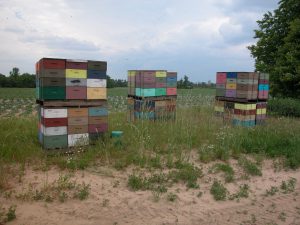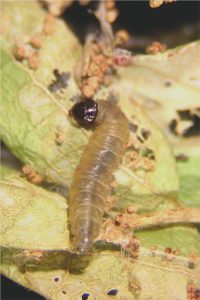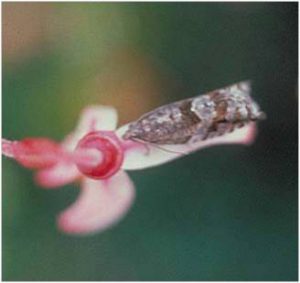Peach
Oriental Fruit Moth: Oriental fruit moth is the primary key insect in peaches that is the ‘worm in the fruit’. It has 4 generations in NJ. During the first 2 flights, eggs are laid primarily on leaf petioles and growing shoots. Larvae hatch and mine down the new growth. As the larvae feed on developing shoots, flagging is seen when the growing terminal dies and falls over. Some eggs from the second generation and much of the 3rd and 4th generation are laid on the fruit surface. When the larva hatch, they bore into the fruit, causing infested fruit. First generation timings are updated below:
| OFM 1st Generation Timing | |||
| Insecticide Type | |||
| County/Region | Degree Days by 5/10 base 45 | Conventional 170-200, 350-375 |
Diamide 100-150, 300-350 |
| Gloucester – Southern | 315 | 1st – past 2nd – 5/12-5/13 |
1st – past 2nd – 5/9-5/12 |
| Hunterdon – Northern | 227 | 1st – past 2nd – 5/19-5/21 |
1st – past 2nd – 5/15-5/18 |
Plum Curculio (PC): PC adults usually begin egg laying once the fruit is out of the shuck. Preferred materials that offer PC control now are Avaunt, and Imidan. If using high rates of a neonicotinoid (i.e. Actara, Belay, Assail), be aware that there is a synergistic effect when used in tank mixes with DMI materials (i.e. Rally) with regard to bee toxicity. Neonicotinoids should not be used if there are any flowering weeds in your orchard. Those flowering weeds will attract bees, which will be killed by the insecticide. The use of most of these products when bees are present is off label and therefore not legal. If pyrethroids are being used, then high rates are advisable, since low rates often do not control PC, especially in hot weather. Where PC is a problem, growers should rotate away from pyrethroid insecticides if possible. Actara and Belay will also control PC (and GPA), but not OFM. [Read more…]



